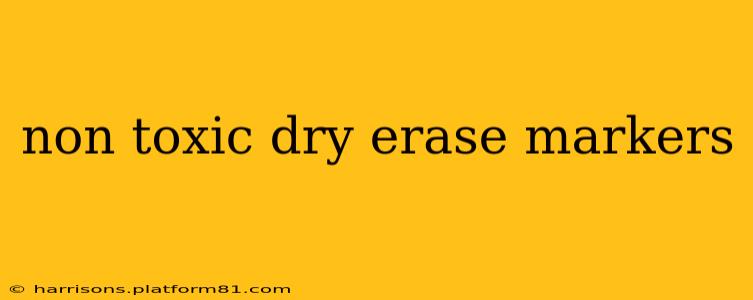Dry erase markers are a staple in classrooms, offices, and homes. However, the safety of these markers, especially for children, is a growing concern. Many conventional dry erase markers contain volatile organic compounds (VOCs), which can be harmful if inhaled or ingested. This comprehensive guide explores the world of non-toxic dry erase markers, addressing common questions and helping you make informed choices.
What Makes a Dry Erase Marker "Non-Toxic"?
The term "non-toxic" can be misleading. Strictly speaking, no substance is completely without toxicity at some level. However, when referring to non-toxic dry erase markers, it generally means they are free from or have significantly reduced levels of harmful chemicals like:
- Volatile Organic Compounds (VOCs): These are chemicals that easily evaporate at room temperature and can contribute to air pollution and health problems. Common VOCs in some markers include xylene, toluene, and ethylbenzene.
- Phthalates: These are chemicals used to make plastics more flexible, but some can be endocrine disruptors.
- Formaldehyde: A known carcinogen.
Non-toxic dry erase markers often use alternative solvents and pigments that minimize these harmful substances, making them a safer option, particularly for children and individuals sensitive to chemicals.
Are Non-Toxic Dry Erase Markers as Effective as Regular Markers?
Many people worry that non-toxic markers might compromise performance. This is a misconception. While the formulation is different, leading brands produce high-quality non-toxic dry erase markers that write smoothly, erase cleanly, and offer vibrant colors. The writing experience should be comparable to conventional markers.
What are the Best Brands of Non-Toxic Dry Erase Markers?
Several reputable brands focus on producing non-toxic dry erase markers. Researching specific products and reading customer reviews is always recommended. Look for markers that clearly state they are non-toxic and list their ingredients. Check for certifications like AP (Art & Creative Materials Institute) non-toxicity seals for added assurance. (Note: I cannot endorse specific brands as product availability and formulations can change.)
How Can I Tell if My Dry Erase Markers are Non-Toxic?
Carefully examine the marker's packaging. Look for labels that explicitly state "non-toxic," "low VOC," or similar claims. Check the ingredient list for the presence of harmful chemicals mentioned above. If the information is unclear or unavailable, consider choosing a different brand.
What are the Benefits of Using Non-Toxic Dry Erase Markers?
The primary benefit is the reduced exposure to potentially harmful chemicals. This is particularly crucial for children, who are more vulnerable to the effects of toxins. Other benefits include:
- Improved indoor air quality: Reducing VOCs contributes to a healthier environment in classrooms and homes.
- Peace of mind: Knowing you're using a safer product can alleviate parental concerns.
- Environmental responsibility: Some non-toxic markers utilize more eco-friendly materials.
Can I Use Non-Toxic Dry Erase Markers on all Surfaces?
Generally, non-toxic dry erase markers perform well on standard dry erase boards, whiteboards, and most other smooth, non-porous surfaces. However, always test a small, inconspicuous area first to avoid potential staining or damage.
How Do I Dispose of Used Non-Toxic Dry Erase Markers?
While non-toxic, these markers should still be disposed of properly. Check your local waste management guidelines for recommendations on marker disposal. In many areas, they can be disposed of in regular household trash.
In conclusion, choosing non-toxic dry erase markers is a simple step towards creating a healthier and safer environment for yourself and your family. By making informed choices and understanding the difference between conventional and non-toxic options, you can enjoy the convenience of dry erase markers without compromising safety.
